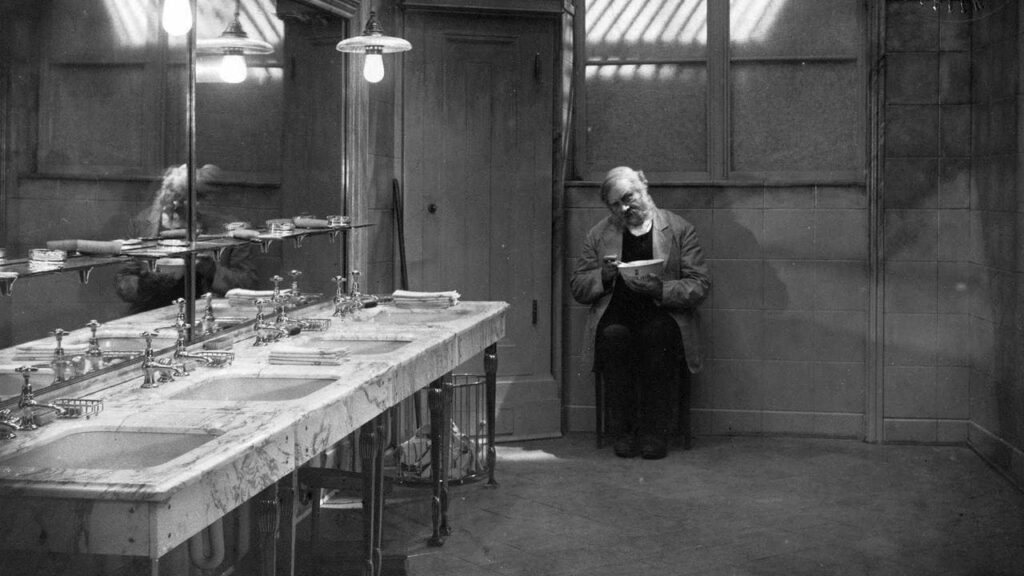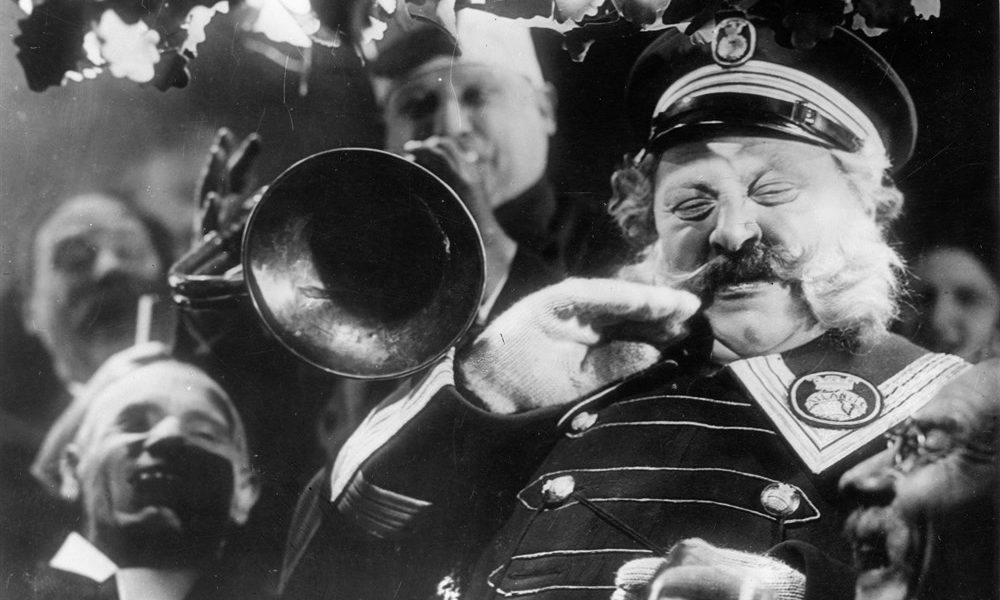The history of the decline and fall of the doorman empire
The Last Laugh is tightly bound to the time and place in which it was created. And yet, like many hyper-specific stories, it finds some universal truths. In his commentary track, film historian Noah Isenberg notes that Emil Jannings’ nameless protagonist, a hotel porter, is visually coded in a way that register as old and fusty to young Germans: his mutton chops are modeled after portraits of Wilhelm I, the late emperor. Jannings’ straight-backed stoicism in his doorman’s uniform a reminder of the German military’s failures that led to the economic despair of the early Weimar Republic. In other words, he’s a man who hasn’t realized that the glory of the era he grew up in has passed the world by.
So much of this film is tied with the specific cultural context of the Weimar Republic, and so many details in The Last Laugh enrich that setting. But the scenario itself is a universal one: We’ve all know older people who don’t adjust to fast-paced modern life, so different from what they grew up in. Inevitably, the world changes and speeds up. Age comes for us all; whether it hits with a soft landing of introspective dignity or crashing down in petty corncob humiliation, we can’t be sure until it’s too late. Usually it’s a little bit of both.
F. W. Murnau, one of the great silent era directors, captures Jannings’ character from both of these angles: we laugh at the doorman’s self-importance; and we weep when he loses what little he has and finds a hollow nothing in its place. Murnau pairs with revolutionary cinematographer Karl Freund and influential scenarist Carl Mayer in creating a film of tremendous emotional power and visual innovation to explore this character. The Last Laugh deeply immersed and touched me, and I wouldn’t hesitate in giving it the highest praise I can muster if not for a bizarre and flippant ending.

The story follows Jannings’ character over a few fateful days. We first meet him as the porter of the Atlantic Hotel, which is a true achievement of set design. The hotel is centered around an enormous rotating door, a construction of tremendous power and suggestion — always spinning like an urban windmill or human roulette wheel. Murnau stages the doorman’s routine such that we immediately understand the character. We see the regality with which he treats the doorman position, and we even understand: There’s a magnificence and buzz to the hotel that draws you in. We also witness the slowness and oldness of his body in the midst of the youthful commotion of the hotel. He is ripe for a stumble, both literal and figurative.
The fall does indeed come. Jannings’ character walks into the hotel one day and is distraught to see a new doorman who is younger, taller, and stronger. He’s summoned to the manager’s office where he’s given a demotion slip: He will attend the toilet. Worse yet: He won’t get to wear his uniform. I think it’s important that a reduction in pay is never explicitly mentioned as part of the demotion; the pain he goes through is not financial angst but prestige angst.
These scenes of Jannings interacting with his manager are shot with an almost absurd anguish, as if he’s received a terminal diagnosis rather than a reassignment. But in a way, he actually has received a terminal diagnosis: The toilets are where doddering geezers work as they count down to retirement. Jannings’ one claim to fame — his shiny uniform and small position of pride as doorman — has been taken, and this loss sucks the life from him.
The neighborhood in which Jannings’ character resides is fascinating: It’s a lower-class apartment, full of a very different kind of life from the hotel. People are crammed together, but not so feverishly busy as the hotel guests. And yet they are clearly living lives full of activity: We see the wedding for Jannings’ niece, women sweeping the common area, kids playing.

His neighbors seem to humor and even appreciate Jannings’ character in uniform. They treat him as if he’s a policeman or an authority figure. He helps comfort bullied kids and mentor young adults. But when his neighbors discover he’s been stripped of his doorman duties, reduced to wearing a drab white shirt as a restroom attendant, they turn on him and disown him. This really surprised me: I expected that the crowd wouldn’t care one way or the other and would still respect him as a neighborhood elder. This suggests to me that Murnau and Mayer are most interested in a scathing, culture-wide satire of interwar Germany rather than just the stuffy old folks.
Murnau invites us to explore these settings — the hotel, the lower-class neighborhood — with some of the most visionary and virtuoso camerawork I’ve ever seen. Film historian Isenberg gives most of the credit to cinematographer Freund for pioneering this technique of sinuous camera movement (and Freund was eager to take the credit, later resenting Murnau’s reputation as a genius that was built, in part, on Freund’s camerawork). Admirers and imitators would label the technique “entfesselte Kamera” — the unchained camera, smoothly flowing with a life of its own, drawing us deeper into the heart of the story. It offers a tremendous sense of space and tactility. The lighting is deliriously beautiful, especially in a nighttime stroll through the hotel’s hallways towards the end of the film. At times, the lighting resembles the film noir chiaroscuro that would grow popular in genre films 20 years later.
The result of the emotional story and the marvelous craft is a film that offers a rare, sublime experience. I was subsumed into The Last Laugh in a way that I am reading great novels but rarely while watching a film. The lack of intertitles results in a steady, immersive flow of the story that’s almost zen-like. The Last Laugh may very well be the most touched I’ve ever been by a silent film.
So an outright masterpiece… but for those final fifteen minutes.
Before I go on, I’ll give a spoiler warning to this century-old film. I advise you go watch the film — the Kino Lorber DVD has a beautiful transfer, which you can watch on Kanopy or Amazon Prime. Heck, you can stream the same transfer directly from Wikipedia. You have no excuse not to see this. But let’s continue.

How do you end a story about a man’s downfall? Redemption? Some sort of absolution and acceptance? Death? Here’s how Murnau and Mayer answered the question: With Jannings’ character at rock bottom, we get an intertitle — in fact, the only intertitle in the whole film (excluding some close-ups on in-universe writing, like his demotion letter). This title card states that Jannings inherited a fortune from a dying patron of the hotel that he had helped earlier. Jannings’ character is now fabulously wealthy. He and the night watchman, who had been kind to him throughout the film, enjoy a decadent meal at the hotel. They are now the guests of honor. They ride off on a carriage into the sunset. The young, burly new doorman salutes Jannings. And they lived happily ever after.
Huh?
It is such a jarring happy ending that it swerves past implausible into surreally fake. Why did Murnau and Mayer end their tragedy on such a false note? Like much great art — and The Last Laugh is great art — it opens itself up to subjective interpretation by defying expectations. That doesn’t mean it’s a good ending, of course, but it’s at least interesting.
In the commentary track, Isenberg speculates that production company UFA, in their first collaboration with Murnau, pressured him to create an ending that wouldn’t alienate or depress viewers. Murnau acquiesced but made it so outrageously fake that he was blowing raspberries at UFA. He would trust the viewers to detect that this was a papered-on happy ending, that real tragedy only avoided with some sort of divine intervention.

That aligns with another possible reading of the finale, that Murnau and Mayer are satirizing the way poor Germans at the time constantly glorified and fantasized about winning unearned fortunes through inheritance or lotteries during the economic downturn: Indeed, Jannings’ newly wealthy hero is only celebrated once the announcement of his windfall lands in the papers and makes him a local legend.
A final possible take on the finale is that it is happening inside Jannings’ head. Because it’s introduced with the film’s lone title card, it interrupts the film’s flow in a new and unexpected way, suggesting some sort of split in reality. Just before the cut, we see him hunched over, introspective, perhaps about to submit to his depression and construct a fantasy in his head.
Whatever your interpretation may be, the ending is a middle finger to the audience. It’s a sour note wrapping a genuine masterpiece that precedes it. It’s not quite so timeless or iconographic, but this really is a better film than Nosferatu, and certainly a better piece of cinematic technique and visual storytelling.
Is It Good?
Exceptionally Good (7/8)
Dan is the founder and head critic of The Goods. Follow Dan on Letterboxd. Join the Discord for updates and discussion.


4 replies on “The Last Laugh (1924)”
Well, obviously I need to see this ASAP.
Can I say Dan, I think you’ve been doing the Lord’s work with the in-depth write-ups you’ve done for some of these silent movies lately. Between this and La Roue, I’ve got some catching up to do.
The comments about how false the ending feels remind me of some interpretations I’ve heard of the ending of Taxi Driver.
I appreciate the kind words, Andrew! The Last Laugh is only 1.5 hours to La Roue’s 7 hours, so I’d prioritize this between the two. I’m slowly working through films listed on 1001 Movies You Must See Before You Die and trying to review them as I go.
I actually haven’t seen Taxi Driver, but as soon as I described this to Brian, he mentioned that film as well. Yet another reason for me to finally bite the bullet on that one.
The lack of intertitles and the camera work makes it stand apart from other silent films. I would argue, due to almost being language/subtitle-less, it’s more humanistic in nature and has a much broader appeal.
The acting by the lead old man was quite good despite the over the top histronics popular in that era. The ending is definitely jarring and takes a complete U turn from that point.
Kirk – I completely agree. It really sucks you in. I remember feeling the way I feel when reading a good novel. And I’m with you on Jannings performance — it’s a great one. Thanks for stopping by and commenting!